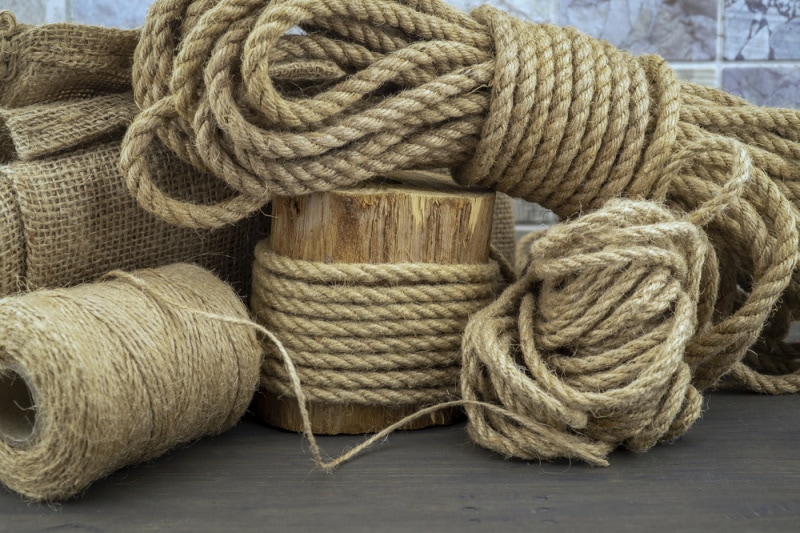Is Jute Rope Safe for My Cats to Play With? Vet-Approved Safety Guide
Updated on

Jute rope is a fiber extracted from plants of the same name and woven together into strong threads. It is frequently used as a craft twine, but it can also be used to make cat toys. But is this natural material safe for felines? Jute is completely safe for cats to scratch, and jute toys are a good option for kitties that like this material, although your cat needs to be supervised while playing with them. However, it’s not recommended to offer your cat single strands of jute rope to play with since these can become a foreign body hazard with life-threatening consequences.
Most cats, especially mischievous kittens, have a hard time resisting a dangling rope or string, so you must watch your kitty while they’re playing with jute rope to make sure they don’t ingest any loose fibers. Moreover, it’s always a good idea to regularly inspect your cat’s toys for signs of wear and replace them if they’re damaged or frayed, as they could pose a choking hazard to your cat.
You should also be aware that some cats may have sensitivities or allergies 1 to natural materials like jute or sisal, so if you notice any skin signs, like itchiness or redness, it’s best to remove the toy and seek your vet’s advice.
Here’s what you need to know about jute rope and how to keep your cat safe during playtime.
Is Jute Rope the Same as Sisal?
While both are eco-friendly materials and commonly used to make cat toys and scratching posts, there are a few key differences between the two:
- Origin: Sisal is obtained from the leaves of the agave plant native to Mexico. Jute is extracted from the bark of the white jute plant and is mainly cultivated in Bangladesh and India.
- Color: Sisal is usually light cream, while jute is more of a darker brown. However, both materials can be dyed.
- Fibers: Sisal fibers have a coarse, stiff texture. Jute fibers are long, soft, and shiny. This difference in texture can impact the durability of the material, with sisal being generally more resistant to repeated scratching.

What Are the Potential Risks of Jute for Cats?
Yarn and twine are products made from jute fibers that can be hazardous to cats if ingested during play. These materials can lead to serious complications if they get wrapped around the intestines and become a linear foreign body. In this situation your cat may show digestive issues like vomiting, drooling, diarrhea, nausea, loss of appetite, dehydration, abdominal pain, and even fever. When this occurs, prompt veterinary intervention is vital for your cat’s recovery.
Although jute rope is not as “thin” as yarn or twine, it can become damaged over time. Cats can play with the frayed bits and ingest them, which can lead to gastrointestinal issues. Also, any toy with a rope, regardless of the material, can be dangerous for kittens. Rope toys can quickly get wrapped around their neck or a limb, causing them to panic. Due to a kitten’s small size, a few rolls or kicks can lead to strangulation or loss of blood flow to a limb.
However, these frightening situations can be avoided by constantly supervising your cat or kitten when they’re playing with rope toys and removing them when playtime is over.
What Else Should Cats Not Play With?
Many seemingly harmless objects found in a home can pose a potential danger to curious kittens:
- Strings, hair ties, ribbons, and sewing threads
- Wool yarn
- Sharp objects (anything with sharp edges, such as scissors, needles, or pins)
- Electrical cords
- Paperclips
- Plastic bags
- Tiny things that are easy to swallow
- Frayed carpet edges
- Shoelaces
- Dental floss
- Christmas tinsel
Keep these items out of reach of your cats. If you suspect that your cat has ingested something that they shouldn’t have or they are showing signs of distress or gastrointestinal issues (vomiting, diarrhea, refusal to eat, etc.), contact your veterinarian right away.
How Can You Make Sure Your Cat Is Safe During Playtime?
To keep your cat safe while they’re playing with their toys—whether they’re made of jute rope or not—you should take a few precautions:
- If you buy small furry toys, such as mice, be sure to remove eyes, plastic noses, or any other parts that could be swallowed.
- Avoid cat toys that have small parts that can easily detach and be swallowed, such as strings, bells, ribbons, and buttons, or at the very least, remove these potentially dangerous items.
- If you want to get scratching posts made of jute rope, make sure they are dye-free and natural in color. Some rope dyes can be toxic to cats.
- Consider buying interactive toys, as these may be safer items to keep your cat stimulated and entertained.
- Always supervise your cat’s playtime and remove any toys that are damaged or could pose a potential hazard.
These precautions may seem extreme for some cat owners, especially if their cat is old and spends most of their days curled up on the top shelf of the cat tree.
Still, it’s best to keep these tips in mind to be on the safe side, especially if you want to welcome a new kitten into your household at some point.
Final Thoughts
So, should you get toys and scratching posts made of jute rope for your precious feline? As long as you carefully supervise your cat’s playtime and check their toys regularly, there should be no problems with this material. But if you’re looking for a sturdier scratching post to withstand your cat’s multiple assaults, you might want to consider sisal instead.
Featured Image Credit by: NetPix, Shutterstock












